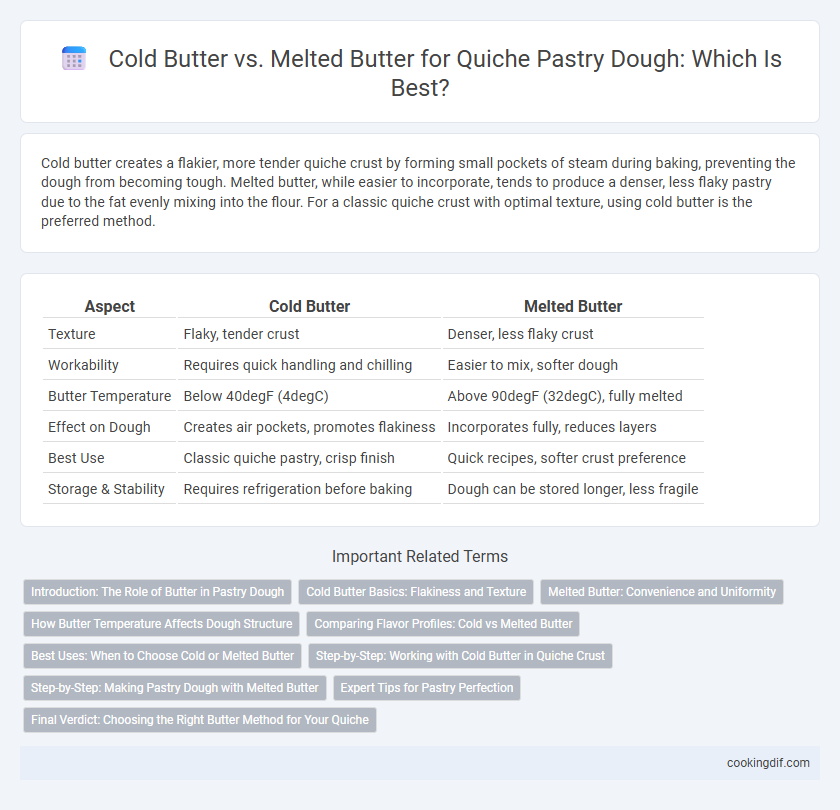Cold butter creates a flakier, more tender quiche crust by forming small pockets of steam during baking, preventing the dough from becoming tough. Melted butter, while easier to incorporate, tends to produce a denser, less flaky pastry due to the fat evenly mixing into the flour. For a classic quiche crust with optimal texture, using cold butter is the preferred method.
Table of Comparison
| Aspect | Cold Butter | Melted Butter |
|---|---|---|
| Texture | Flaky, tender crust | Denser, less flaky crust |
| Workability | Requires quick handling and chilling | Easier to mix, softer dough |
| Butter Temperature | Below 40degF (4degC) | Above 90degF (32degC), fully melted |
| Effect on Dough | Creates air pockets, promotes flakiness | Incorporates fully, reduces layers |
| Best Use | Classic quiche pastry, crisp finish | Quick recipes, softer crust preference |
| Storage & Stability | Requires refrigeration before baking | Dough can be stored longer, less fragile |
Introduction: The Role of Butter in Pastry Dough
Butter's temperature critically influences pastry dough texture; cold butter creates flaky layers by producing steam during baking, while melted butter results in a denser, tender crust due to full fat integration. The moisture content in cold butter helps form pockets in the dough, enhancing flakiness essential for quiche pastry. Choosing between cold and melted butter determines the dough's structural properties and final mouthfeel, impacting overall quiche quality.
Cold Butter Basics: Flakiness and Texture
Cold butter in quiche pastry dough creates distinct layers as it melts during baking, resulting in a flaky, tender crust texture ideal for holding rich fillings. Unlike melted butter, which blends uniformly and produces a denser dough, cold butter ensures small pockets of fat remain, key to achieving the classic, airy flakiness. Properly chilled butter also controls dough temperature, preventing gluten overdevelopment and maintaining optimal crumb structure in the final quiche crust.
Melted Butter: Convenience and Uniformity
Melted butter offers convenience and ensures uniform distribution throughout quiche pastry dough, resulting in consistent texture and flavor. Its liquid state simplifies mixing, reducing preparation time and preventing uneven pockets of fat that cold butter might cause. This method produces a tender, cohesive crust ideal for quiche, balancing flakiness with structural integrity.
How Butter Temperature Affects Dough Structure
Cold butter in quiche pastry dough creates small, solid fat pockets that melt during baking, resulting in a flaky and tender crust due to steam formation. Melted butter blends thoroughly with flour, producing a denser, less layered texture that may lack the desired crispness. Proper control of butter temperature directly influences dough structure by affecting gluten development and moisture distribution in the pastry.
Comparing Flavor Profiles: Cold vs Melted Butter
Cold butter in pastry dough creates a flaky, tender texture with a rich, buttery flavor due to small, solid fat pockets that steam during baking. Melted butter yields a denser, more uniform crumb and a slightly intensified buttery taste because the fat is fully incorporated, enhancing overall richness. Choosing between cold and melted butter impacts both the mouthfeel and the depth of buttery flavor in quiche crusts.
Best Uses: When to Choose Cold or Melted Butter
Cold butter is ideal for quiche pastry dough when a flaky, tender crust is desired because it creates small, distinct layers as it melts during baking. Melted butter works best for quiche recipes requiring a denser, more crumbly crust, providing a richer flavor and easier dough handling. Selecting cold butter preserves structure and flakiness, while melted butter enhances moisture and a tender mouthfeel in the finished quiche.
Step-by-Step: Working with Cold Butter in Quiche Crust
Working with cold butter ensures a flaky quiche crust by creating steam pockets during baking, which results in a tender texture. Cut cold butter into small cubes and incorporate it quickly into the flour using a pastry cutter or fingertips until the mixture resembles coarse crumbs. Keep the dough chilled before rolling out to maintain the butter's solid state, preventing a greasy crust and promoting optimal flakiness.
Step-by-Step: Making Pastry Dough with Melted Butter
Using melted butter in pastry dough creates a tender, crumbly texture ideal for quiche crusts, as it fully integrates with the flour, reducing gluten formation. Step-by-step, combine melted butter with chilled water and flour, mixing just until the dough comes together to avoid overworking. This method simplifies dough preparation and yields a rich, flaky base perfectly suited for savory quiche fillings.
Expert Tips for Pastry Perfection
Cold butter creates a flaky, tender quiche crust by forming small, solid fat pockets that steam during baking, while melted butter results in a denser, more uniform texture. Expert pastry chefs recommend chilling butter and cutting it into the flour until it resembles coarse crumbs to achieve optimal flakiness and buttery flavor. Avoid overworking the dough to prevent gluten development, which can toughen the pastry and detract from the ideal quiche crust texture.
Final Verdict: Choosing the Right Butter Method for Your Quiche
Cold butter creates a flaky, tender quiche crust by maintaining solid fat pieces that release steam during baking, while melted butter yields a denser, less structured dough. For the ideal quiche pastry, cold butter is preferred to achieve the classic crisp texture and lightness. Bakers seeking a delicate, buttery crust should prioritize cold butter over melted for optimal quiche results.
Cold butter vs melted butter for pastry dough Infographic

 cookingdif.com
cookingdif.com